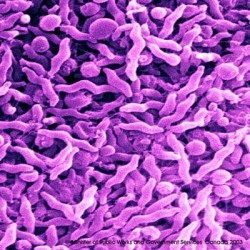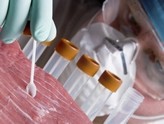Scientific breakthrough in fighting food industry pathogens

The findings have been made by a group led by Dr Arnoud van Vliet and strategically funded by the Biotechnology and Biological Sciences Research Council, at the UK’s Institute of Food Research.
Campylobacter is responsible for an estimated half a million cases of food poisoning annually solely in the UK.
Converting nutrients into energy is essential to all forms of life and without this process, known as respiration, life would not exist in harsh and hostile conditions. This holds true for the foodborne bacterial pathogen Campylobacter, which colonises the intestines of poultry.
In this environment it uses organic acids produced by other bacteria to respire and thrive. Campylobacter needs selenium to make the formate dehydrogenase enzyme required for this respiration. Until now little progress had been made in how selenium is acquired or metabolised by Campylobacter or many other bacteria.
Campylobacter genes identified
However, Dr van Vliet’s group has identified two Campylobacter genes which are required for the formation of the formate dehydrogenase enzyme.
Inactivation of these two genes blocked the formation of the formate dehydrogenase enzyme. But when the bacteria were supplemented with extra selenium, they were able to synthesize the enzyme again, suggesting that the two Campylobacter genes are involved in selenium metabolism.
It has been previously shown that the lack of formate dehydrogenase affects the ability of Campylobacter to colonise the chicken gut. Consequently the fresh research may open up possibilities to target this pathway for antimicrobial purposes.
Implications for other areas of food safety
In addition, the selenium metabolism genes and the formate dehydrogenase enzyme are also present in other important foodborne pathogens including Salmonella and E. coli. As a result it may be possible to extend such investigations to other areas of food safety, claim the researchers, who have published their findings in the Journal of Bacteriology.
"Selenium metabolism is still poorly understood in bacteria, and its role in important foodborne pathogens like Campylobacter is not yet appreciated fully,” said Dr van Vliet. "With the identification of these two genes essential for formate respiration, we now hope to have a tool to generate knowledge that helps us get a better understanding of what makes Campylobacter so good in colonising the chicken gut and cause disease in humans. Such knowledge is essential if we want to achieve the ultimate goal of reducing the impact of Campylobacter in the food industry."
Source: Selenium-dependent biogenesis of formate dehydrogenase in Campylobacter jejuni is controlled by the fdhTU accessory genes, Shaw et al, Journal of Bacteriology doi: 10.1128/JB.06586-11















